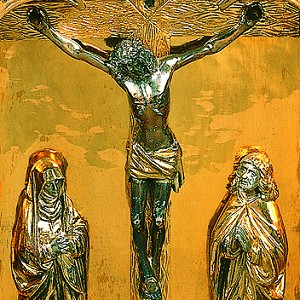
Ways to discover the collection
Private devotions
Not all artworks in the Middle Ages were made to celebrate the liturgy or furnish churches. Beginning in the 14th century, a growing number of small-scale pictures, sculptures and graphics were created for the private devotions of individual believers. Renderings of Christ on the Cross with exaggerated wounds or the Resurrected Christ as “Man of Sorrows” were to help believers re-create the suffering of Christ for themselves and bring them to feel compassion (compassio). These devotional images also include what is known as the Pietà (Italian for compassion): The Virgin Mary mourns her dead son, whom she is presenting to the observer as he lies across her lap. This type of imagery is always intended to elicit an emotional response from the observer. It has been said that nuns in Southern German convents vicariously experienced the birth of Jesus while looking at small cribs of the infant Jesus. Paternoster necklaces and rosaries were made for the act of prayer. Sometimes, individual rosary beads could be viewed from both sides, the first half depicting a person, the other a skeleton, encouraging viewers to reflect on the transience of this life. Small clay figurines or paper-pulp reliefs were often of inferior artistic quality but affordable for everyone. Small graphical devotional images that were thought to have a special efficacy were sold at pilgrimage sites. One such example involved small pieces of paper called Dreikönigenzettel (Magi notes). Having touched the relic, these notes were imbued with healing powers and could protect the owner from many a misfortune. Some pictures could even be swallowed as holy medicine.














